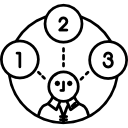Blockchain: Difference between revisions
Mr. MacKenty (talk | contribs) No edit summary |
Mr. MacKenty (talk | contribs) No edit summary |
||
| Line 19: | Line 19: | ||
</html> | </html> | ||
== See also == | |||
* [[51% attack]] | |||
* [[Block]] | |||
* [[Block header]] | |||
* [[Candidate block]] | |||
* [[Collision resistance]] | |||
* [[Cryptocurrency]] | |||
* [[Cryptographic hash]] | |||
* [[Determinism]] | |||
* [[Digital signature]] | |||
* [[Distributed consensus]] | |||
* [[Double-spend problem]] | |||
* [[Entropy]] | |||
* [[Genesis block]] | |||
* [[Immutable transactions]] | |||
* [[Key pair generation]] | |||
* [[Ledger]] | |||
* [[Merkle proof]] | |||
* [[Merkle tree]] | |||
* [[Miner]] | |||
* [[Mining]] | |||
* [[Nonce]] | |||
* [[Non-invertibility]] | |||
* [[Non-repudiation]] | |||
* [[One-way function]] | |||
* [[Proof of work]] | |||
* [[PuTTYgen]] | |||
* [[Self-referential data structure]] | |||
* [[SHA256]] | |||
* [[Takeover attack]] | |||
* [[Transaction pool]] | |||
== References == | == References == | ||
Revision as of 10:15, 6 March 2020

Computational thinking, problem-solving and programming[1]
A block chain is a growing list of records, called blocks, that are linked using cryptography. Each block contains a cryptographic hash of the previous block, a timestamp, and transaction data (generally represented as a Merkle tree).[2]
A blockchain is a decentralized, distributed, and oftentimes public, digital ledger that is used to record transactions across many computers so that any involved record cannot be altered retroactively, without the alteration of all subsequent blocks[3]
Videos[edit]
The video below is easily the best video explanation I have found explaining blockchain. I would suggest you watch it several times.
The video below is a very good high-level overview of blockchain:
See also[edit]
- 51% attack
- Block
- Block header
- Candidate block
- Collision resistance
- Cryptocurrency
- Cryptographic hash
- Determinism
- Digital signature
- Distributed consensus
- Double-spend problem
- Entropy
- Genesis block
- Immutable transactions
- Key pair generation
- Ledger
- Merkle proof
- Merkle tree
- Miner
- Mining
- Nonce
- Non-invertibility
- Non-repudiation
- One-way function
- Proof of work
- PuTTYgen
- Self-referential data structure
- SHA256
- Takeover attack
- Transaction pool